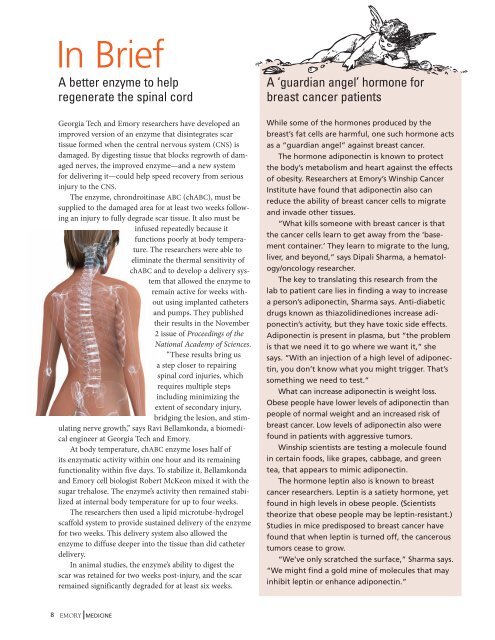medicine - Woodruff Health Sciences Center - Emory University
medicine - Woodruff Health Sciences Center - Emory University
medicine - Woodruff Health Sciences Center - Emory University
You also want an ePaper? Increase the reach of your titles
YUMPU automatically turns print PDFs into web optimized ePapers that Google loves.
8<br />
In Brief<br />
A better enzyme to help<br />
regenerate the spinal cord<br />
Georgia Tech and <strong>Emory</strong> researchers have developed an<br />
improved version of an enzyme that disintegrates scar<br />
tissue formed when the central nervous system (CNS) is<br />
damaged. By digesting tissue that blocks regrowth of damaged<br />
nerves, the improved enzyme—and a new system<br />
for delivering it—could help speed recovery from serious<br />
injury to the CNS.<br />
The enzyme, chrondroitinase ABC (chABC), must be<br />
supplied to the damaged area for at least two weeks following<br />
an injury to fully degrade scar tissue. It also must be<br />
infused repeatedly because it<br />
functions poorly at body temperature.<br />
The researchers were able to<br />
eliminate the thermal sensitivity of<br />
chABC and to develop a delivery system<br />
that allowed the enzyme to<br />
remain active for weeks without<br />
using implanted catheters<br />
and pumps. They published<br />
their results in the November<br />
2 issue of Proceedings of the<br />
National Academy of <strong>Sciences</strong>.<br />
“These results bring us<br />
a step closer to repairing<br />
spinal cord injuries, which<br />
requires multiple steps<br />
including minimizing the<br />
extent of secondary injury,<br />
bridging the lesion, and stimulating<br />
nerve growth,” says Ravi Bellamkonda, a biomedical<br />
engineer at Georgia Tech and <strong>Emory</strong>.<br />
At body temperature, chABC enzyme loses half of<br />
its enzymatic activity within one hour and its remaining<br />
functionality within five days. To stabilize it, Bellamkonda<br />
and <strong>Emory</strong> cell biologist Robert McKeon mixed it with the<br />
sugar trehalose. The enzyme’s activity then remained stabilized<br />
at internal body temperature for up to four weeks.<br />
The researchers then used a lipid microtube-hydrogel<br />
scaffold system to provide sustained delivery of the enzyme<br />
for two weeks. This delivery system also allowed the<br />
enzyme to diffuse deeper into the tissue than did catheter<br />
delivery.<br />
In animal studies, the enzyme’s ability to digest the<br />
scar was retained for two weeks post-injury, and the scar<br />
remained significantly degraded for at least six weeks.<br />
EMORY MEDICINE<br />
A ‘guardian angel’ hormone for<br />
breast cancer patients<br />
While some of the hormones produced by the<br />
breast’s fat cells are harmful, one such hormone acts<br />
as a “guardian angel” against breast cancer.<br />
The hormone adiponectin is known to protect<br />
the body’s metabolism and heart against the effects<br />
of obesity. Researchers at <strong>Emory</strong>’s Winship Cancer<br />
Institute have found that adiponectin also can<br />
reduce the ability of breast cancer cells to migrate<br />
and invade other tissues.<br />
“What kills someone with breast cancer is that<br />
the cancer cells learn to get away from the ‘basement<br />
container.’ They learn to migrate to the lung,<br />
liver, and beyond,” says Dipali Sharma, a hematology/oncology<br />
researcher.<br />
The key to translating this research from the<br />
lab to patient care lies in finding a way to increase<br />
a person’s adiponectin, Sharma says. Anti-diabetic<br />
drugs known as thiazolidinediones increase adiponectin’s<br />
activity, but they have toxic side effects.<br />
Adiponectin is present in plasma, but “the problem<br />
is that we need it to go where we want it,” she<br />
says. “With an injection of a high level of adiponectin,<br />
you don’t know what you might trigger. That’s<br />
something we need to test.”<br />
What can increase adiponectin is weight loss.<br />
Obese people have lower levels of adiponectin than<br />
people of normal weight and an increased risk of<br />
breast cancer. Low levels of adiponectin also were<br />
found in patients with aggressive tumors.<br />
Winship scientists are testing a molecule found<br />
in certain foods, like grapes, cabbage, and green<br />
tea, that appears to mimic adiponectin.<br />
The hormone leptin also is known to breast<br />
cancer researchers. Leptin is a satiety hormone, yet<br />
found in high levels in obese people. (Scientists<br />
theorize that obese people may be leptin-resistant.)<br />
Studies in mice predisposed to breast cancer have<br />
found that when leptin is turned off, the cancerous<br />
tumors cease to grow.<br />
“We’ve only scratched the surface,” Sharma says.<br />
“We might find a gold mine of molecules that may<br />
inhibit leptin or enhance adiponectin.”
















